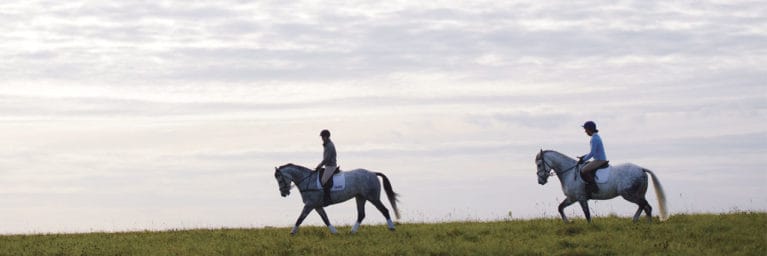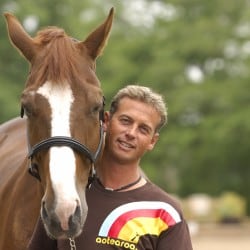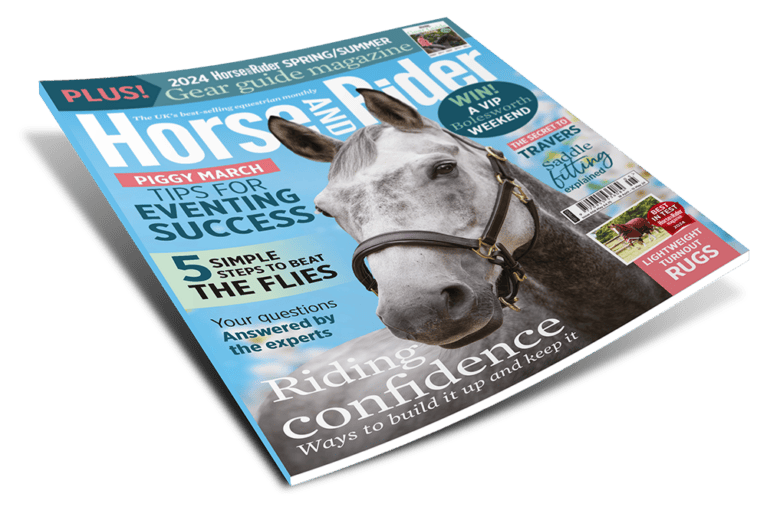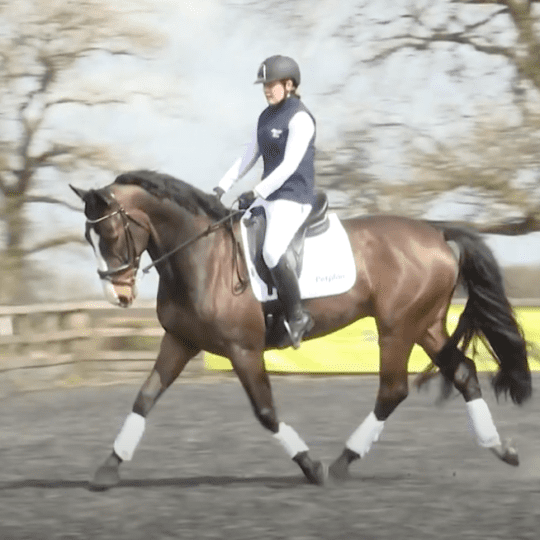Featured Professional

Lucinda Fredericks
Best known for her partnership with Headley Britannia, Lucinda rides for Australia and has won Burghley, Badminton, and Rolex Kentucky.
Even professional riders use time outside the arena to improve their horse’s way of going. Olympic eventer, Lucinda Fredericks, shares her tips for motivating a laid-back type

Even professional riders use time outside the arena to improve their horse’s way of going. Olympic eventer, Lucinda Fredericks, shares her tips
New horses arrive at my yard all the time. Some of them I’ve chosen as matches for clients and others I’ve ridden and thought, ‘I like you’, so bring them home to see if I can progress their training. Of all the horses I’ve ridden, trained, bought and sold, no two have been the same. That’s the trick with horses – understanding that they’re as individual as people.
By taking your horse’s personality into consideration and designing a training programme that suits his character, he will learn skills in a way that feels natural to him. The importance of getting to know a horse’s character and working with it is something I learnt from my first horse, a just-backed four-year-old Holstein mare called Miss Emmalu. She was highly intelligent, tricky, nappy and stubborn. She was also the only horse I had, so I had to find ways to get along with her.
Figuring out how to work with Miss Emmalu kick-started my education in understanding horses as individuals with highly developed personalities and I learnt how to adapt training methods so they worked best for each character. She came along at the right time in my career and I’ve got her to thank for preparing me so thoroughly for a lifetime of working with lots of interesting horsey personalities.
How to devise a plan
Whether you’ve had your horse for years or, like me, are working with a new personality, there’s a suite of checks that it’s important to go over before embarking on a new schooling plan. After all, no matter how much hard work you put into your horse, if there’s an underlying issue that’s unresolved, you’re wasting your time. I like to know that he’s feeling his best before I start challenging him in his training, so every equine arrival at my yard goes through the same MOT procedure…
- when he arrives, the horse is isolated from the main yard so his health can be closely monitored for 10–14 days
- the MOT starts at the front – a dental technician checks his teeth, a physiotherapist checks his body and back, and the farrier sets up a shoeing programme
- he’ll also be worm-counted and a nutritionist works with us to develop a feeding programme to suit his condition and level of work. I start new horses on feed rations at the lower end of the energy scale. This lets me get to grips with their character and personality before pumping them full of calories. I’ll know soon enough whether I want more or less energy and more or less condition
- we’ll lunge him to watch how he moves and check his state of mind – if he’s feeling fresh, getting straight in the saddle may give you both an unnecessary fright and set back your confidence
We learn a lot about the horse during this process, discovering how he feels in his body, what he’s like to handle and his attitude to life. It means that when I ride him for the first time, I know about his character and personality, so I can focus on his reactions to my aids. I ask myself…
- Is he naturally straight, forward and equal in my hands?
- Does he stop, go, turn and rein-back when I ask?
Each response tells me something about his education and helps me design a plan of work to help him progress and develop.
Top top – When devising a plan for your horse, imagine you’re handling and riding him for the first time. What would a stranger say about him? Don’t let your affection for him colour your judgement of what needs to improve.
Professional hacking plan: boost suppleness, manners and rideability
These four easy exercises tackle each element, then piece them all together.
Exercise 1. Rideability: Zigzag leg-yield up a hill
Exercise 2. Suppleness: Pushing in walk downhill
Exercise 3. Manners: Walk pirouettes
Exercise 4. Rideability, suppleness and manners: Shoulder-in and leg-yield along a fence line
How it can work for you
Clever, balanced horses like Harry can trot enthusiastically around an arena without doing a stitch of work. While it may look good and feel okay, you’re never going to improve your horse’s way of going by schooling within his comfort zone. With hills, slopes and terrain to deal with, there’s no hiding from work when you go hacking. And every horse can benefit from improved rideability and suppleness.
Meet Harry
Our model, Harry, is a gentleman to handle and much too sensible to bounce around on the lunge. In fact, he’s a very workmanlike sort of horse. He moves correctly and feels straight, with even, rhythmical paces. Harry has had some good training along the way and has the potential to be a very mobile, supple horse. But now he’s left his previous life as a hunter in Ireland and is destined for a career as an event horse, so he needs to learn to engage his body more to produce better work.
The benefits of schooling on a hack
Harry is a forward-thinking horse and I can use this natural impulsion to great effect when schooling outdoors. I want to harness this energy to develop his suppleness and rideability – his commitment to going forward will provide the energy I need to move his body into new shapes, whereas in the arena he may get confused.
Schooling out hacking in this way helps your horse maintain his enthusiasm for life because he isn’t being drilled in the arena every day. This is especially important for a horse like Harry, who hasn’t spent very much time in an arena. While Harry has a host of new skills to learn, I’d rather work him outdoors where he feels confident and happy, rather than in the arena where he may lose the natural forward energy that will make schooling easy for him.
Top tip – Creating and maintaining suppleness is important for your horse’s long-term soundness – some horses are naturally bendy, while some have to work at it.
Exercise 1: Rideability
What’s rideability? – This is when your horse accepts, understands and reacts to your aids. You can move a rideable horse around your leg and ask him to go faster or slower, or move left or right. A rideable horse is safer in every situation, from respecting a rein aid to halt at a junction to adopting shoulder-in past something scary. A horse who over- or under-reacts to your aids is difficult to manage. It’s important to cultivate understanding and responsiveness to your aids, so eventually you can use softer and softer aids.
Zigzag uphill leg-yield
Yielding to your leg is the foundation of everything you do with your horse. I ask Harry to move away from my leg in walk and trot in a zigzag up tracks.
Real-world goal
Ensuring your horse respects your leg can help keep you safe – if he spooks towards traffic, being able to hold him straight with your leg can prevent him stepping out towards cars.
Exercise 2: Suppleness
What is suppleness? – A supple horse is one who gives you a feeling of elasticity, flexibility and strength when you ride him – as if you were able to manoeuvre him with soft aids into any position or movement. Supple horses are able to bend and flex, then flex within the bend, and it feels as though you have fingertip control of his hindlegs in a light contact.
Power walk downhill
I love walking horses downhill. The slope encourages them to step further forward with their hindlegs under their body to create greater overtrack, which generates more swing. This opens up their shoulders and articulates their back. Walking downhill also develops core stability and sure-footedness – they have to readjust themselves to maintain balance. Pushing them forward with a relaxed contact and a round neck protects them from the temptation to jog and teaches them about the potential range they have in walk.
Real-world goal
A strong core and flexible back will help your horse move easily. Ease of movement helps reduce unnecessary wear and tear on your horse’s limbs and joints.
Exercise 3: Manners
What are manners? – Horses need to be polite to handle and ride – it’s much nicer when your horse leads nicely, stands to be mounted and doesn’t tug at the reins. Some horses are naturally gentle and polite, while others need reminding to stay humble and on the job. Manners are taught by being consistent, patient and polite yourself, and using clever exercises such as walk pirouettes to avoid battles or confrontations.
Walk pirouettes
Walk pirouettes are about asking your horse to move around your outside leg in a soft way. The pirouette is a real test for him mentally and physically, as he needs to articulate his body step-by-step, in balance and on your aid.
I’ve chosen a spot on a track with high sides, so there’s a natural barrier to contain us. It’s interesting to see what evasion the horse reaches for in a walk pirouette – when it gets difficult for him, what does he do? In Harry’s case, he tenses the underside of his neck to resist my leg aid at the same point of the pirouette each time. This knowledge will help me design schooling exercises to help keep this area soft.
Real-world goal
Training your horse to move away from your outside leg can help you open a gate or move into a driveway to let a vehicle pass.
Exercise 4: Rideability, suppleness, manners
Shoulder-in against a fence line
The landscape out hacking will help your horse develop his lateral work – for example, teaching shoulder-in using a fence line. The fence acts as a pressure line, supporting your aids to manoeuvre
your horse onto a shoulder-in angle.
Start your shoulder-in in walk to give your horse time to co-ordinate his legs and get used to the feel of working on an angle. Schooling in shoulder-in on varying terrain is physically challenging. Whereas in an arena all your horse has to think about is the
angle, on grass he has to engage, pick his feet up, maintain his balance and be more aware of where
he’s placing his feet.
As your horse understands the concept, you can move further and further away from the fence line.















